
The Narwhal’s TC Energy investigation makes the Jackman Award shortlist
We’re excited to share that an investigation by The Narwhal is a finalist for the...
In the narrows between Lake Michigan and Lake Huron sits a twin pipeline pumping 540,000 barrels per day of natural gas liquids and crude oil from Alberta and Saskatchewan through Michigan to Sarnia, Ont. For more than 65 years, the pair of 6.5-kilometre pipelines has rested exposed in the Straits of Mackinac, moving oil near delicate wetlands and through fish spawning habitats where swift currents pull water between the Great Lakes.
A decade ago, Michigan scientists, conservationists and tribes began warning that Enbridge’s Line 5 was a disaster waiting to happen. Now a renewed dispute over the pipeline is exposing how reliant both sides of the Canada-U.S. border are on the movement of fossil fuels through aging pipes.
There are many ways the lines could burst, according to Dave Schwab, a researcher at the University of Michigan’s Water Center. The most likely scenario, he said, is that a ship’s anchor could strike a pipe. Lighter than water, the oil would rush to the surface and spread, riding the currents.
“Where the oil would end up is a crapshoot,” Schwab said.
In 2016, he simulated 840 possible spills in various currents and conditions and found that more than 1,100 kilometres of shoreline in lakes Michigan and Huron were vulnerable to an oil spill, with American shoreline and islands at highest risk. Schwab’s simulations showed oil could reach Canadian shores, too, including Ontario’s Manitoulin Island and Bruce Peninsula. He warned the scale of a Line 5 leak could match the devastating 2010 Kalamazoo River spill, also from an Enbridge pipeline in Michigan, that cost more than US$1 billion to clean up.
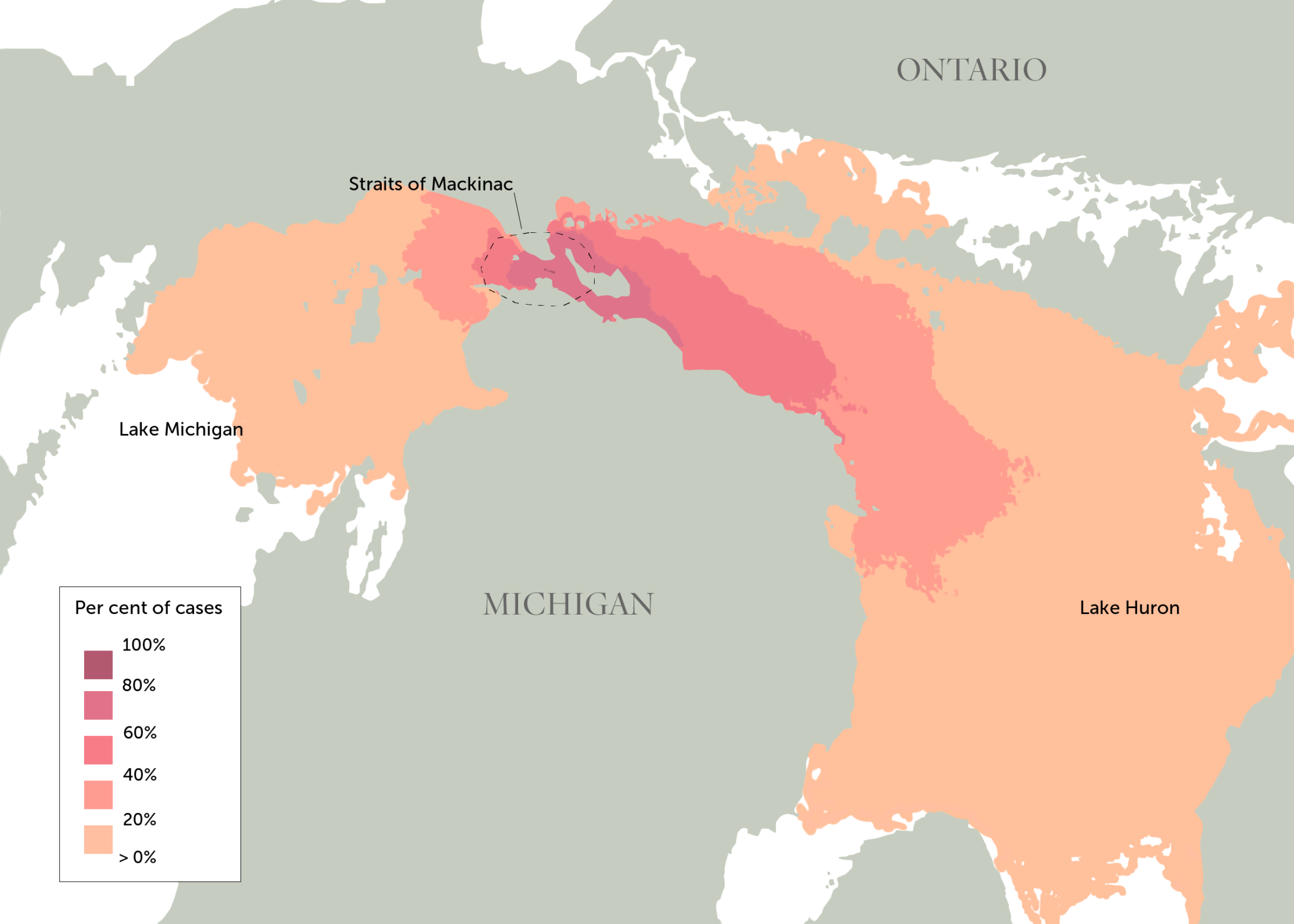
In 2016, Dave Schwab, a researcher at the University of Michigan’s Water Center, simulated 840 possible spills from Line 5 near the Straits of Mackinac. This map shows the percentage of cases in which oil is present at any time after initial release. Source: Michigan Water Center. Map: Carol Linnitt / The Narwhal
After Schwab completed his report, a ship dragged an anchor across the pipelines; it didn’t break them but did scrape away coating that prevents corrosion. “We got lucky, very lucky,” he said.
Schwab said there’s only one way to get the likelihood of a spill to zero: “Turn off the pipeline.”
And that’s exactly what some people want to do.
Elected on a promise to shut down Line 5 once and for all, Michigan Governor Gretchen Whitmer is seeking a legal order to halt the flow of oil through the pipeline, calling it an “unreasonable risk” to the Great Lakes. The order’s original deadline of May 12 has long since passed with no resolution in sight.
Enbridge has refused to shut down the line and is fighting back in court. In response to safety concerns, the company wants to build a tunnel below the straits to house Line 5, but permits are pending and the project would take years to build, while the pipeline continues to threaten the Great Lakes.

Michigan’s Democratic Governor Gretchen Whitmer campaigned on a promise to shut down Enbridge’s Line 5 pipeline. Photo: Junfu Han / Detroit Free Press/TNS/ABACAPRESS.COM
Meanwhile, Canadian politicians are busy making contingency plans and backchanneling with American leaders; on March 3, Canada’s Natural Resources Minister Seamus O’Regan called U.S. Energy Secretary Jennifer Granholm and framed the Line 5 issue as a potential energy crisis. “There is a lot at stake for our provinces, there is a lot at stake nationally, and therefore the federal government is watching this like a hawk,” O’Regan said in a recent committee meeting.
Experts echo his concerns, saying if Line 5 shuts down, residents and corporations in Ontario and Quebec will face higher prices for gasoline, home heating and jet fuel as the crude and natural gas liquids will likely need to move by truck and rail with higher transportation costs. Ontario Minister of Energy, Northern Development and Mines Greg Rickford said it would put thousands of jobs at risk and increase Ontario’s reliance on fuel transport by rail, truck and sea.
The question of a shutdown hinges on a U.S. court decision that Michigan hopes will reaffirm its cancellation of the pipeline’s easement through the straits, although Canadian politicians hope it may yet be decided through international diplomacy or the invocation of a little-known treaty. Meanwhile, Indigenous nations on both sides of the border are watching closely, ready to protect their rights with litigation if necessary.
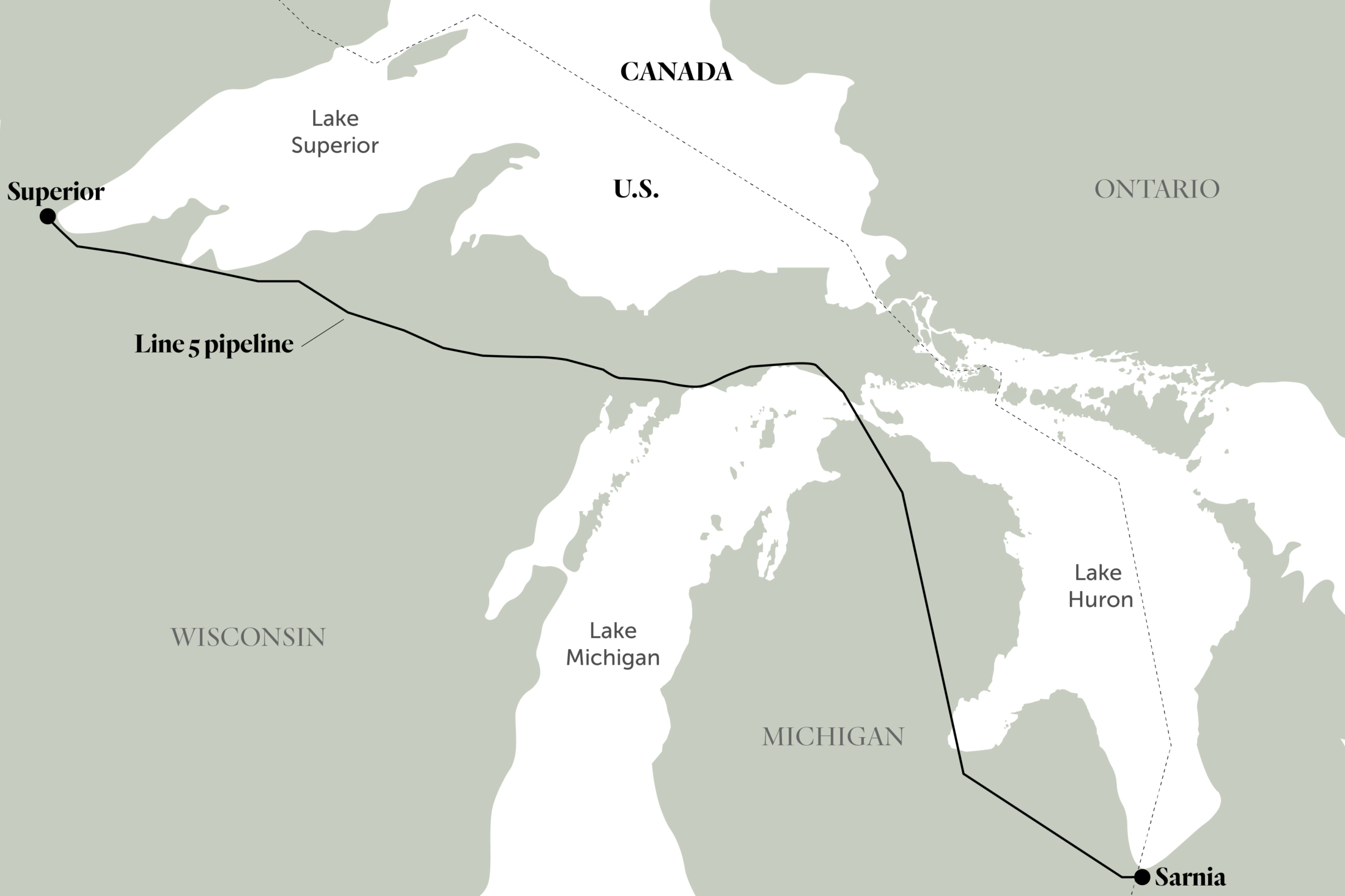
Every day, Line 5 moves 540,000 barrels of natural gas liquids and crude oil from Alberta and Saskatchewan through Michigan to Sarnia, Ont. Map: Carol Linnitt / The Narwhal
Michigan first granted Line 5’s easement through the straits in 1953. After construction, the pipeline rested on the lakebed largely unnoticed by the public until 2010, when two massive oil spills hit headlines. In April 2010, the Deepwater Horizon oil rig exploded and sank in the Gulf of Mexico, the result of an underwater well blowout that caused the largest marine oil spill in history. Three months later, Enbridge Line 6B, part of the same Lakehead System as Line 5, burst, releasing more than three million litres of diluted bitumen from Canada’s oilsands into Talmadge Creek and the Kalamazoo River. It was the largest inland oil spill in U.S. history.
The Kalamazoo spill pulled public focus like a magnet to Enbridge pipelines in Michigan, and environmental groups including the National Wildlife Federation began investigating Line 5. “After that spill, we started asking a lot of questions,” said Beth Wallace, manager of conservation partnerships for the federation and the lead staffer on Line 5. “Because really it was out of sight, out of mind.”
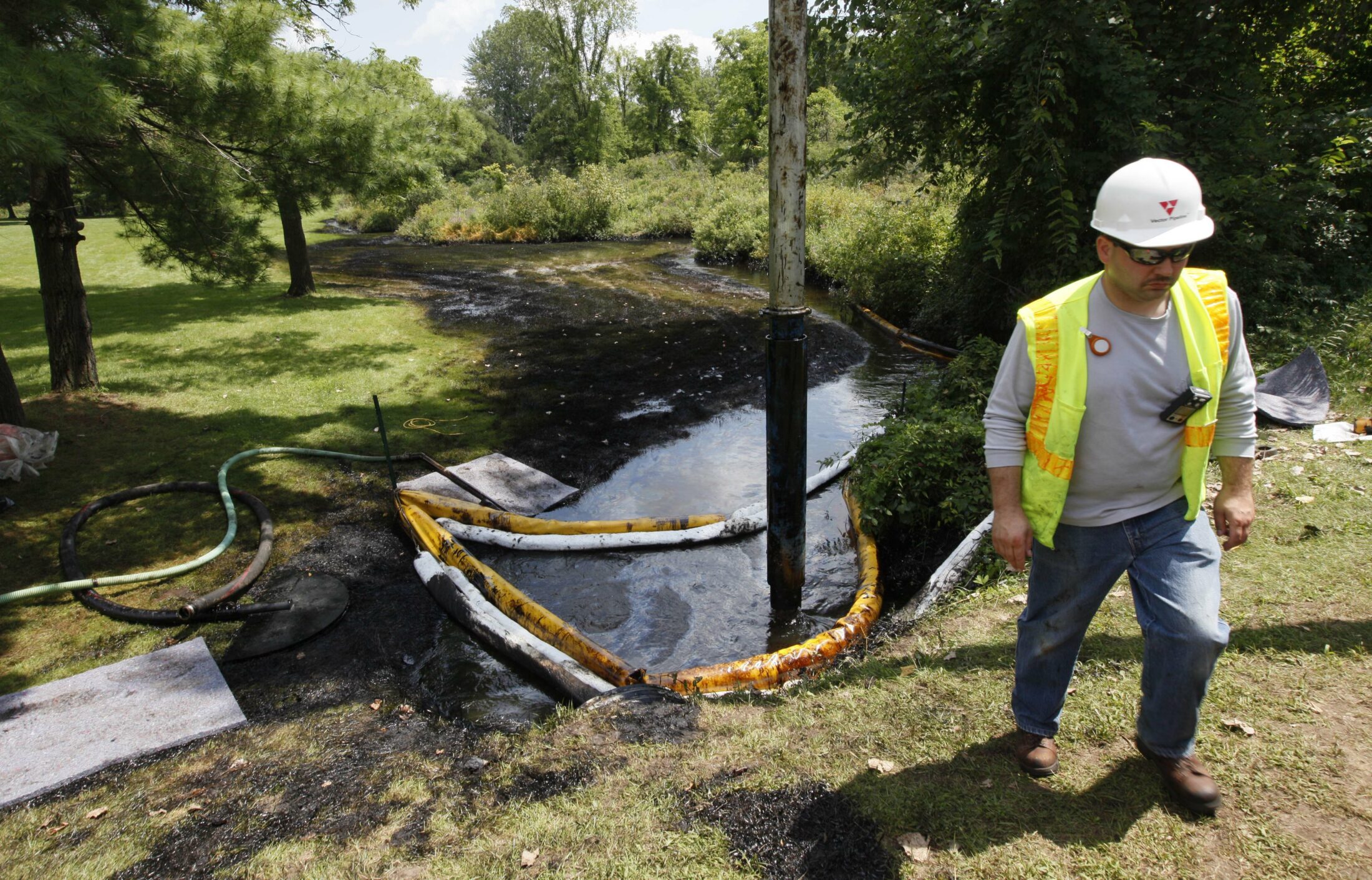
A worker monitors the water in Talmadge Creek as diluted bitumen from the ruptured Enbridge Line 6B is vacuumed out after the devastating 2010 spill. Photo: Paul Sancya / Associated Press
The federation requested information from state and federal agencies and Enbridge, dug through news archives and filed freedom of information requests, but couldn’t get answers to simple questions, including how often Line 5 was inspected, or if there had been spills or repairs. So, in 2013, they commissioned divers to record video of the pipeline’s condition.
State rules say the pipe must be anchored every 75 feet (about 23 metres) to prevent stress, but the video revealed that huge spans were unsupported — something that had been a problem for more than a decade. An internal 2003 Enbridge report found stretches as long as 286 feet (about 87 metres) were unsupported — a finding that the company only made public in 2016 as a requirement of its Kalamazoo spill settlement.
Without supports, Wallace said the strong currents could bend the pipe over time, leading to a potential spill. The video also revealed sections of the pipeline were covered in invasive mussels that can release acid and corrode the pipe’s surface.
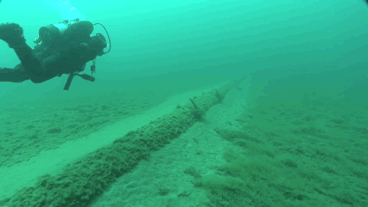
The National Wildlife Federation commissioned divers to examine the state of the Line 5 pipeline in 2013. Video: National Wildlife Federation
In 2014, prompted by the federation’s findings and public fears following the Kalamazoo spill, then-governor Rick Snyder launched a task force to examine Line 5. In 2017, Michigan’s Pipeline Safety Advisory Board began looking at alternatives for Line 5’s path through the straits.
In 2017, the release of records increased public concern: the National Wildlife Federation published data from inspection records obtained through a freedom of information request that showed land-based sections of Line 5 had leaked 29 times since 1968, spilling more than one million gallons of oil. The records showed construction issues and manufacturing defects in the pipe. That same year, Enbridge pressure tested the line and declared it was “in excellent health and fit for service.” The company also added support anchors, assuring the public they weren’t more than 75 feet apart.
In late 2018, voters elected Whitmer and Michigan Attorney General Dana Nessel after the duo vowed to begin the legal process to shut down Line 5. In June 2019, Nessel and Whitmer followed through on that promise, filing the first of a series of legal actions aimed at decommissioning the pipeline.
Enbridge maintains the line is safe and there has been no oil spill in the straits in Line 5’s history. The company told The Narwhal it monitors its pipelines closely and takes safety seriously. Enbridge said it has tested a full-scale emergency response and would cover all costs if a spill happens, which is required under U.S. and Canadian regulations.
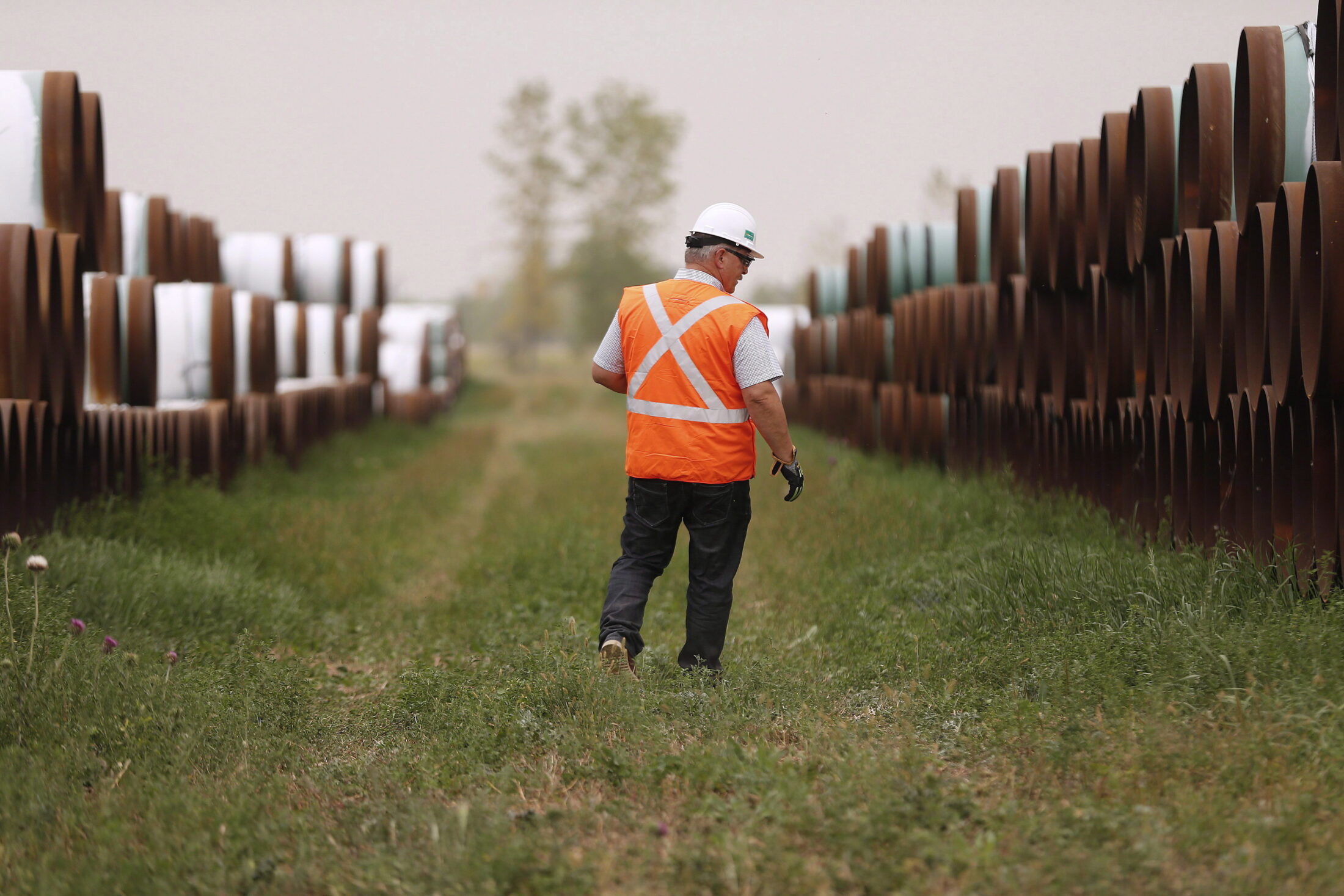
Les Scott, former senior community advisor for Enbridge walks through an oil pipe storage facility just west of Morden, Man., during a tour of locations for the Line 3 pipeline, a part of the company’s Lakehead System. Photo: John Woods / The Canadian Press
But recent incidents raise doubts about Line 5’s safety; in spring 2020, Enbridge inspected the pipeline and found that sometime in 2019 another ship had marred the pipeline by dragging a cable across it, removing protective coating and damaging an anchor support. Of the five vessels that potentially caused the damage, four of them were contracted by Enbridge, the company’s report found.
And in June 2020, the U.S. Environmental Protection Agency fined Enbridge US$6.7 million for failure to repair dents and cracking in its larger Lakehead System. As part of a consent decree Enbridge had signed after the Kalamazoo spill, the company had promised to quickly repair problems in the Lakehead System but had neglected to do so.
In November 2020, Michigan cancelled the 1953 easement for Line 5, citing a review by the state’s Department of Natural Resources that found Enbridge had repeatedly violated terms of the easement.
In February, Michigan’s Department of Environment, Great Lakes and Energy approved permits for the company to build a tunnel under the straits, however the company still needs permits from the Michigan Public Service Commission and the U.S. Army Corps of Engineers. Snyder agreed in 2018 to let Enbridge dig a tunnel under the straits to house the pipeline, rather than leaving it exposed on the lakebed.
In response to Michigan’s legal action, politicians on both sides of the border have pressured Whitmer and Canadian Prime Minister Justin Trudeau to keep the line open, warning of disastrous energy shortages, a spike in fuel prices and job losses.
In a November radio interview, Alberta Premier Jason Kenney said a shutdown would be “devastating” for companies and consumers on both sides of the border. Citing the example of an ethylene pipeline shutdown that caused job losses in the 1990s, Sarnia Mayor Mike Bradley and union leaders in the city have said refineries in the city could close, prompting layoffs.
On March 3, after Conservative MPs questioned Trudeau about Line 5, O’Regan raised the issue during a call with U.S. Energy Secretary Jennifer Granholm. During a meeting of the Special Committee on the Economic Relationship Between Canada and the U.S. on March 4, he said he framed the Line 5 issue as a matter of energy security and discussed the two countries’ shared climate goals. He said Granholm, a former governor of Michigan, understands how critical Line 5 is to the state and the U.S. O’Regan added the Canadian government had raised the issue directly with U.S. President Joe Biden.

Alberta Premier Jason Kenney, left, is one of many politicians who say shutting down Line 5 would create an energy crisis and the federal government, led by Prime Minister Justin Trudeau, right, should take decisive action. Photo: Justin Trudeau / Flickr
If Whitmer succeeds, Ontario and Quebec face the real possibility of an energy crisis, according to Aaron Henry, senior director of natural resources for the Canadian Chamber of Commerce. “This will change the face of Canada’s energy security,” he said in an interview with The Narwhal.
The pipeline is responsible for the fuel that supplies consumers with gas for home heating, gasoline for cars, and jet fuel for at least three major airports in Ontario and Quebec, he explained. “It’s not the case that Line 5 goes offline and all this demand disappears,” he said.
If Line 5 closes, refineries would have to find new supply chains, like moving fuel by rail and truck. The cost of moving that crude would double by rail and quadruple by truck, he said, and refineries would pass that cost along to businesses and consumers in Ontario and Quebec. He agreed with Bradley that layoffs are likely in Sarnia as major refineries scramble to establish new ways to move fuel.
“It’s monumental. It’s a really big impact,” Henry said. “You are looking to pay more to pump the gas in your car, airlines will be looking at higher costs for their jet fuel, and you’re looking at more costs for natural gas to turn on the stove or heat your house.”
But Wallace and others say there are alternatives to Line 5 that can keep the fuels flowing.
One potential alternative raised by Wallace and tribal chairman Mike Wiggins of Wisconsin’s Bad River Band of Lake Superior Chippewa is for Enbridge to divert crude south through recently expanded Line 61 and then north through another line to Sarnia.
According to a 2018 report by the Groundwork Center, a Michigan environmental non-profit, Line 61 doesn’t connect directly to Michigan’s Line 78, which connects to Sarnia, however, “the potential exists to make the connection” to refineries in Canada.
Enbridge said its pipelines can’t make that connection: “There are no pipelines or other alternatives that can readily substitute for Line 5 in transporting the crude oil and natural gas liquids to the refineries and other facilities served by Line 5,” Enbridge spokesperson Tracie Kenyon said in an email.
However, Wallace said other pipeline companies may be able to transport the fuel. “There is a really robust network of pipelines all throughout our region,” she said, adding that the energy system is always changing and the fuel will find its way to market without Line 5.
Right now, the matter of a Line 5 shutdown is in U.S. federal court. When Michigan revoked Enbridge’s easement through the straits, it also asked a state court to affirm its cancellation of the permit. In response, Enbridge removed the matter to federal court — a move any party can take if they believe the case belongs in a different jurisdiction. Next, it’s up to a federal judge to decide whether the case belongs in federal court or if it should be sent back to state court. The federal judge asked for mediation in the case, but that process failed to resolve the dispute. On Sept. 15, Michigan filed in court to call off the mediation, calling it “unproductive.”
Enbridge argues that its regulator is the federal Pipeline and Hazardous Materials Safety Administration, so the case belongs in federal court. However, Salim believes Michigan is right to argue state court is the correct jurisdiction because the issue is not about regulation but instead about the location of the line, which gives the state authority over the easement. He said the state’s revocation of the easement, effective May 12, is valid on its own without the court decision. “If Enbridge continues to operate after the deadline, Enbridge is in violation of state law,” Salim said.
Meanwhile, Canadian politicians are under pressure to take action on a pipeline outside of their borders. On Oct. 4, the federal government invoked the Transit Pipelines Treaty, which had never been used before. The treaty, signed by the U.S. and Canada in 1977, guarantees that pipelines can move fuels between the two countries.

If Line 5 shuts down, Sarnia Mayor Mike Bradley and union leaders say refineries in the city, shown here, could close, prompting layoffs. Photo: Garth Lenz
In a statement explaining the decision, Foreign Affairs Minister Marc Garneau said Canada is “firmly committed to ensuring its energy and economic security while protecting the environment for future generations.”
“In response to Michigan’s efforts to shut down Line 5, Canada has raised its significance for Canadian economic and energy security at the highest levels of the U.S. federal government,” the statement said.
In March, Henry said invoking the treaty would be “a pretty significant button to press” that would heat up relations. “I don’t think that’s the pathway we would necessarily want to go down,” he said.
Margrethe Kearney, senior attorney with the Environmental Law and Policy Center, an advocacy organization based in the U.S. Midwest, said the Transit Pipelines Treaty allows for states and provinces to shut down pipelines, and she believes Michigan is operating within its jurisdiction under the treaty. Invoking it triggers negotiations, and if the parties can’t agree, the issue could go to arbitration. She said the litigation between Enbridge and Michigan could continue concurrently.

Canada’s Natural Resources Minister Seamus O’Regan, left, says there’s a lot at stake with Line 5 and the federal government is watching the issue “like the hawk.” Photo: Justin Trudeau / Flickr
Kearney added that Michigan commissioned a task force into propane disruption and found a Line 5 shutdown would have limited impacts on propane transportation within the state. She suggested Canada launch its own study into the impacts of a shut down.
During the March 4 committee meeting, O’Regan said he wouldn’t give away Canada’s legal strategy and was wary of negotiating in public, but said “we are looking at every option.”
“We are watching it almost on a minute by minute basis and we will be absolutely prepared and ready to intervene at exactly the precise moment,” O’Regan told the committee.
Josephine Mandamin, a member of Wikwemikong First Nation on Manitoulin Island in Lake Huron, walked around every Great Lake before she passed away in 2019 at age 77, travelling more than 17,000 kilometres to raise awareness about water protection. It was Mandamin’s water walks that inspired Wikwemikong Chief Duke Peltier to protect his community’s water.
“We get asked when we cross over back into the spirit world: what did we do in our lives to live in harmony and balance? It’s up to everyone that could be impacted by this pipeline to, at the very least, be aware of it, and be an advocate for protecting that water source.”
Peltier said his nation never consented to Line 5’s construction and he’s deeply concerned that an oil spill could “wreak havoc” on his nation’s traditional territories. Wikwemikong First Nation and Manitoulin Island are unceded territory — there is no treaty that governs the land and water, giving the nation unextinguished interests over Lake Huron. Members of the community fish daily, both commercially and for sustenance. If Line 5 leaks, Peltier fears the impact on the water, fish and ecosystem.
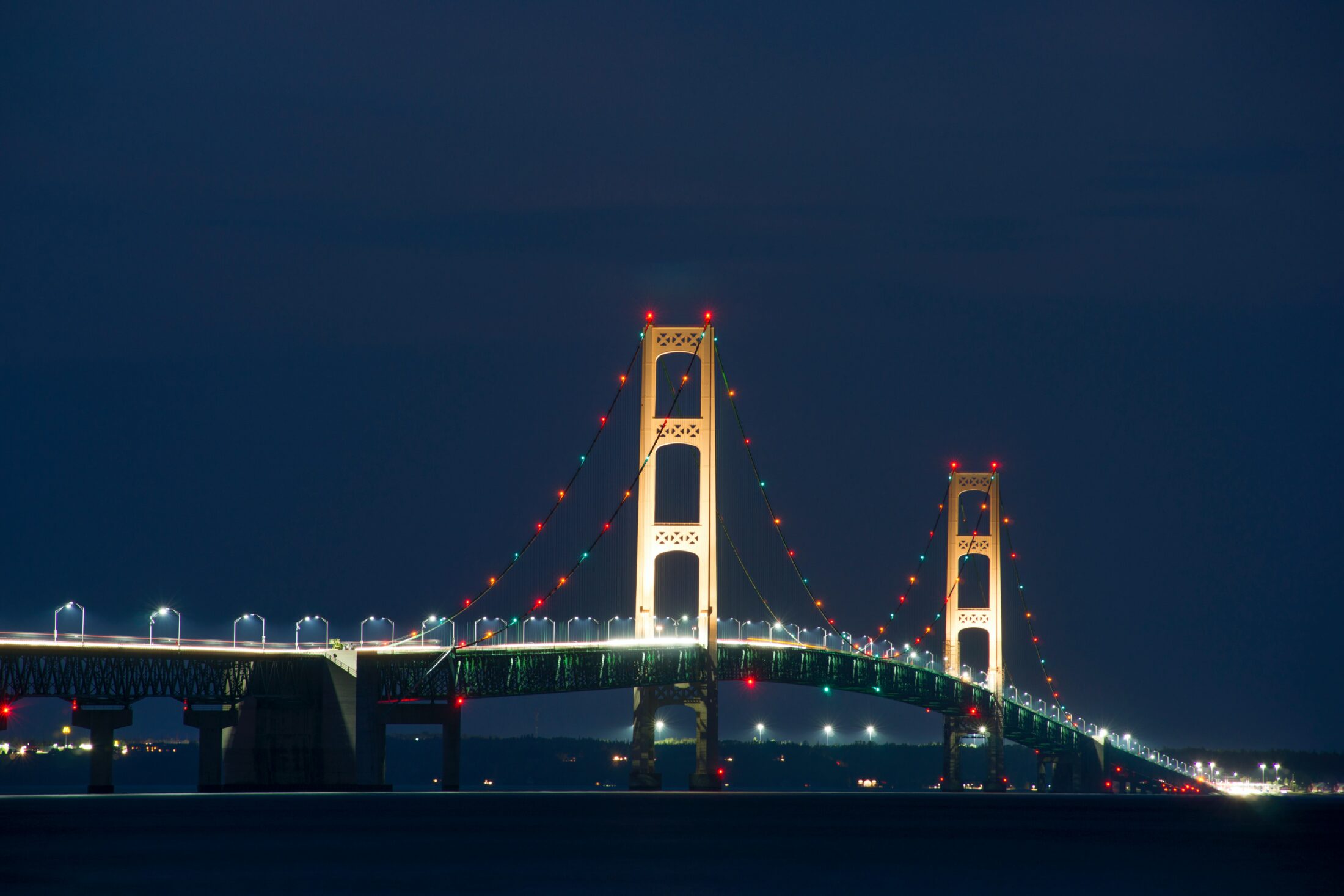
The Mackinac Bridge extends over the Strats of Mackinac near the location of the Line 5 pipeline. Photo: Rudolph Arnstein / Unsplash
Wikwemikong also draws its drinking water directly from Lake Huron. Peltier pointed to Trudeau’s repeated statement that “no relationship is more important to Canada than the relationship with Indigenous Peoples.”
“This is one of those opportunities for the federal government to demonstrate to the citizens of Canada, as well as the First Nations people that live in Canada, how they’re going to protect water,” Peltier said.
Wikwemikong has close relationships with Native American tribes in Michigan, including Bay Mills Indian Community on the upper peninsula, one of a long list of tribes that support decommissioning Line 5.
“We’re talking about protecting our Garden of Eden.”
Whitney Gravelle, tribal attorney for Bay Mills, said her community and four other native tribes signed the 1836 Treaty of Washington with the U.S., which ceded the land that is now Michigan. Under the treaty, the tribes are guaranteed protection of their hunting, gathering and fishing rights in Lake Huron. All five tribes have passed resolutions calling for the shut down of Line 5 through the straits. To the best of Gravelle’s knowledge, none of the five tribes consented to the Line 5 easement. The Narwhal reached out to the other four tribes; two did not reply before publication. Aaron Payment, chairperson of the Sault Tribe of Chippewa Indians, and James Branskey, general counsel of the Little Traverse Bay Bands of Odawa Indians, said their communities were never consulted and did not consent to the easement.
A spill would pollute nearby wetlands, where tribal members collect berries and medicines, and destroy spawning grounds, Gravelle said. Bay Mills members fish daily in the straits for lake whitefish, lake trout, walleye, perch and salmon. They use the fish for sustenance and ceremony and sell it as part of a commercial fishery.
The fish also carry spiritual significance. Gravelle shared a teaching passed down through generations: long ago in a time of famine, her people were suffering. The Creator told the White Fish Clan to walk into the water and sacrifice themselves so they could become lake whitefish and feed the people for the next seven generations. “Our people know that if there is lake whitefish in the water, it is meant to provide for and protect our people,” she said.
The straits were a traditional meeting place and burial grounds for thousands of years before settlers arrived and are now home to archaeological sites. For Anishinaabe people, the creation story takes place at the Straits of Mackinac, Gravelle explained: “We’re talking about protecting our Garden of Eden.”
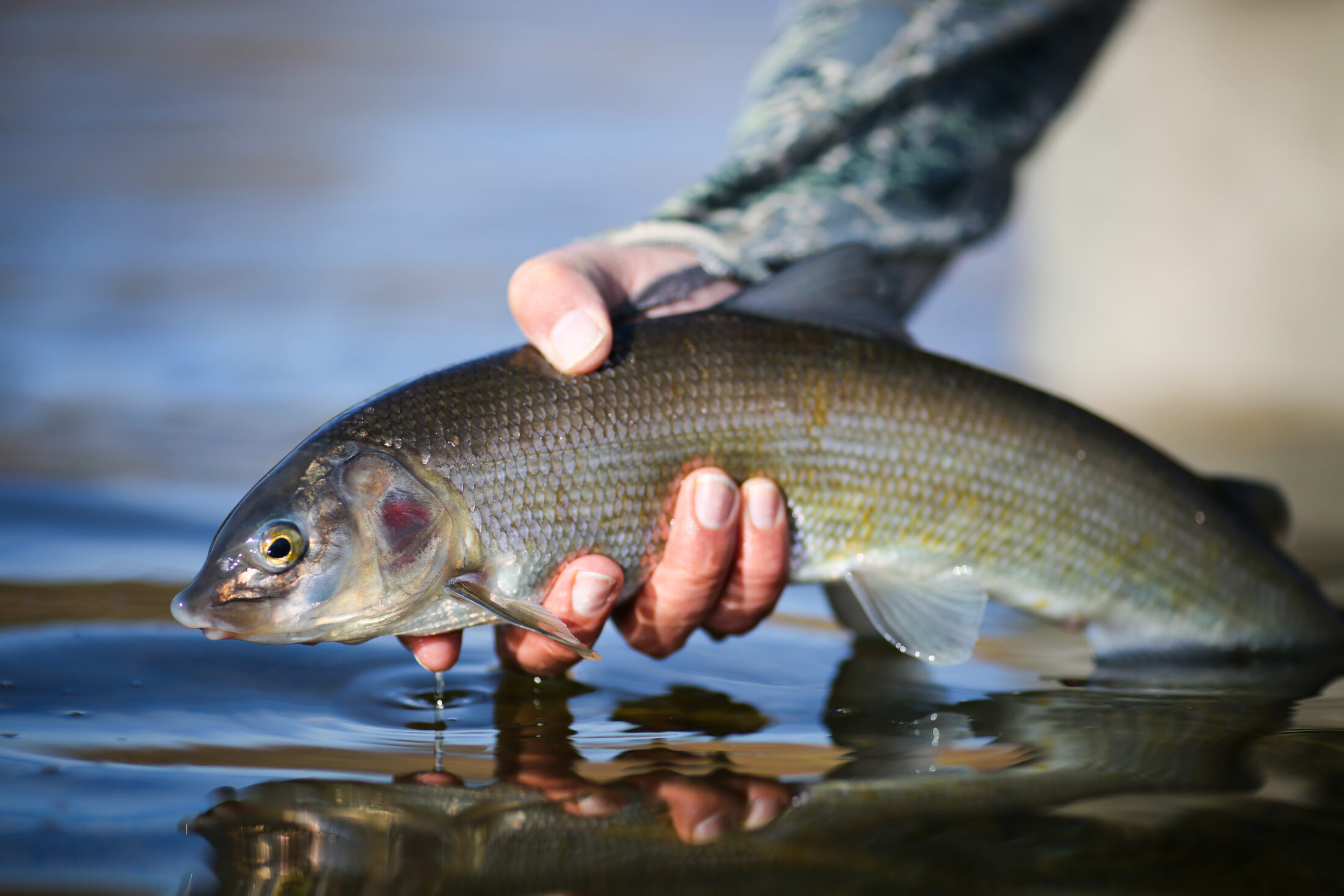
Whitefish are nutritionally, culturally and spiritually significant to the Bay Mills Indian Community, who worry a Line 5 spill could harm the species. Photo: Cannon Colegrove
Tribal Rights are more than just historically and culturally important — they also affect the legal calculus for everyone involved in the Line 5 dispute. The U.S. Supreme Court has upheld treaties with Native Americans as the “supreme law of the land,” Gravelle said. If treaties are broken, tribes can either engage with state and federal agencies or file legal action to reaffirm rights or seek damages after harm.
By law, Gravelle said, state and federal agencies must protect Treaty Rights, meaning they must guard the Great Lakes from a potential oil spill. She referred to a case in which tribes sued Washington State for building culverts that obstructed salmon runs and led to collapse of the fish population. The case went to the Supreme Court, which affirmed a lower court decision siding with the tribes.
Gravelle declined to comment on whether Bay Mills is considering a lawsuit related to the existing section of Line 5 through the straits, but said they are monitoring the situation closely and are challenging permits to the tunnel project. “We’re hopeful that state and federal agencies do what’s right and what is in the public’s best interest,” she said.
Payment wouldn’t say if the Sault Tribe is considering a lawsuit, but said all five tribes that agreed to the 1836 treaty are unified in calling for the shut down of Line 5. When asked about a potential lawsuit, he said, “We could do this the easy way or the hard way.”
It’s not clear how the conflict will end. If approved, the tunnel project wouldn’t be completed before 2024, an optimistic timeline. Whitmer is up for re-election in 2022 and has so far stood her ground. Enbridge has said it won’t shut down the pipeline without a court order, indicating the company is likely to exhaust its legal options. It’s not clear what enforcement action Michigan might take if Enbridge doesn’t close the line. Meanwhile, ships continue to pass through the straits over a pipeline full of oil.
Schwab said the same pipeline could not be approved today due to improved environmental regulations. “What do you do when you’ve got a legacy problem that wouldn’t be allowed to be built today?” Schwab asked. “It’s a tough one.”
— With files from Emma McIntosh
Updated Oct. 6, 2021, at 4:31 p.m. ET: This story was updated to include that Canada has invoked the 1977 Transit Pipelines Treaty, and that Michigan has filed to end mediation talks with Enbridge.
Get the inside scoop on The Narwhal’s environment and climate reporting by signing up for our free newsletter. Angello Johnson’s shoulders burn, and his arms...
Continue reading
We’re excited to share that an investigation by The Narwhal is a finalist for the...

A new documentary, Nechako: It Will Be a Big River Again, dives into how two...

Bracken was recognized for intimate portraits of residents of Fort Chipewyan, Alta., who told her...
